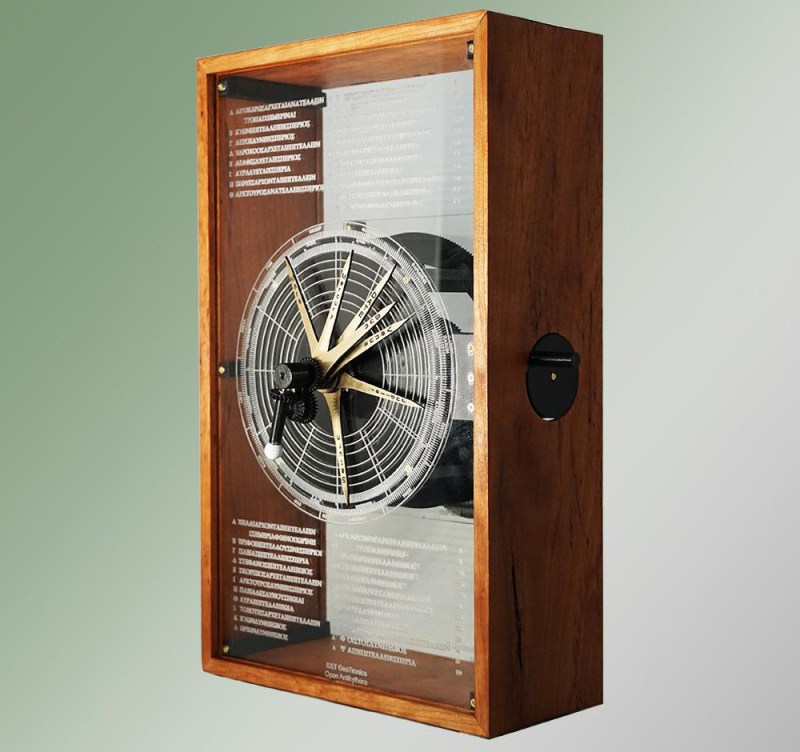When the Antikythera Mechanism was first discovered, it wasn’t viewed as the wonder that we know it today. Originally the divers who found the device and the first scientists to look at it wrote it off as an astrolabe or other some other common type of clock. It wasn’t until decades later when another set of scientists x-rayed the device and surveyed more of the shipwreck where it was found that it began to become one of the more important archaeological discoveries in history. There have been plenty of attempts to recreate this device, and this replica recreates the mechanisms of the original but is altered so it can be built in a modern workshop.
The build, which took the creators several years of research and development to complete, started off with the known gear schemes found on the original device. However, the group wanted to make it with modern technology including 3D printers and laser cutters, so although they worked from an understanding of the original 2000-year-old device there are some upgrades and changes to accommodate those who want to build this in a modern workshop. Gears made from plastic instead of brass have more friction, which needed to be reduced by building custom bearings machined out of brass. And to complete the machine a number of enclosures of various styles are available to use as well.
Additionally, all of the designs and schematics for this build are open source for anyone to build or modify as they would like, although the group putting this together does plan to sell various parts for this as well. There will be some issues with use, as they point out, since the ancient Greeks didn’t have a full enough understanding of cosmology to get a machine like this to stay accurate for two thousand years, but it’s a fascinating build nonetheless. Reasearchers are still discovering new things about this device too, including the recent find of an earliest possible start date for the machine.

















if it isnt hand made by clickspring, i dont want it.
Came here to post the same thing. If it was not created by Chris at ClickSpring, then it might as well not exist (all joking aside, some big media group should have picked up Chris’ video series and made it into a show)
This. But…the ASMR joy of Clickspring aside, the idea of being able to bodge one of these together is enticing.
I came here to make the same comment. Watch Clickspring! It’s maker pron!
I think Chris has quite the loyal following here on HaD. I remember when he was working on his research paper on the mechanism and he told his patreon backers that he was suspending patreon fees until he was back. The majority of us made it quite known that there was no need to do that as we believed in the work that he was doing. I really have no idea how Chris is going to be able to top that.
simple: make a bronze curta calculator…
or did he already do that?
I remember the mantle clock he did prior, and I felt the same way. Then came the…. Antikthera mechanism. And it’s not just the mechanics, but the level of detail in the results. It’s just stunning, and with such rudimentary equipment. True artisanship.
I visited to make the exact same comment.
On the other hand, we now understand that the device as it was originally made suffers from an epoch limit similar to the 32-bit clock on certain computer operating systems.
How far it goes backward and forward before the errors become unacceptable is an interesting question. Please, no one say “42”.
21 x 2
B^)
What do you get if you multiply six by nine?
Niiiccceeee
I’d love an antikythera device of my own… I hope they release a version of the laser cutter files with the text in ancient Greek.
Loads of download links, all of which require a login
Does it show when the next time fissure is, or how to get to Siege of Syracuse?
No, but it predicts the outcome of the Finno-Korean Hyperwar.
Inner or Outer Finland, East or West Korea?
Westerern Australian Museum exhibited Antikther Mechanism Bronze replica engineering drawings and instruction manual are freely avaliable from amclock.net
I would love to have a version of the design that could be made from brass on a desktop CNC.
Using more modern materials, a lowered friction device may work more smoothly. Brass isn’t ideal because of it’s high density, not as stiff as steel, wears rather easily and isn’t inherently low friction. Stainless steel shafts would be stiffer, running in PTFE filled sintered Oilite(TM) buhes and with cyanide case hardened and ground steel gears may offer inherently lower friction and the greater precision that they also offer should significantly improve the efficiency, further reducing friction and wear. If there’s room to fit them, some of the bushes might be replaced with rolling element (deep groove ball) bearings further reducing the friction. Deepest respect and admiration to the original designer whoever it was….